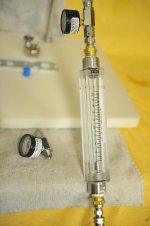rons
Diamond
- Joined
- Mar 5, 2009
- Location
- California, USA
1. Air Compressor performance issue in regards to HVLP spraying. Air compressor outlets are 1" NPT. First filter is 4in diameter, 12in long, with 1" ports. Then other elements further down stream are all 1/2" NPT.
Question: Reducing the tank and first filter to 1/2" NPT and use a 1/2" ball valve between them?
Or using 1" pipe from tank to 1" ball valve. And 1" pipe to first filter, and adjust to 1/2" NPT further downstream. So, is a wider input port on the first filter going to change the coalescing performance. The 1" pipe will be stronger in regards to a given run length and will take more force to rupture it at the tank connection.
2. I'm also using Hoke Gyrolok tube fittings.
Question: Should a thin wall tube (like 5/8 OD which would be used with Hoke 1/2" tube fittings) be trusted to hold the full tank pressure? That would be the run from the tank to the ball valve. Or should thicker pipe and fittings be used from tank to ball valve?
3. Air leakage.
A slow reduction in PSI over a week. Eventually the compressor cycles a few times a year. I think the Hoke fittings will seal better than taped threads.
Question: Reducing the tank and first filter to 1/2" NPT and use a 1/2" ball valve between them?
Or using 1" pipe from tank to 1" ball valve. And 1" pipe to first filter, and adjust to 1/2" NPT further downstream. So, is a wider input port on the first filter going to change the coalescing performance. The 1" pipe will be stronger in regards to a given run length and will take more force to rupture it at the tank connection.
2. I'm also using Hoke Gyrolok tube fittings.
Question: Should a thin wall tube (like 5/8 OD which would be used with Hoke 1/2" tube fittings) be trusted to hold the full tank pressure? That would be the run from the tank to the ball valve. Or should thicker pipe and fittings be used from tank to ball valve?
3. Air leakage.
A slow reduction in PSI over a week. Eventually the compressor cycles a few times a year. I think the Hoke fittings will seal better than taped threads.




 ) hoses can collapse / or break up inside causing problems.
) hoses can collapse / or break up inside causing problems.